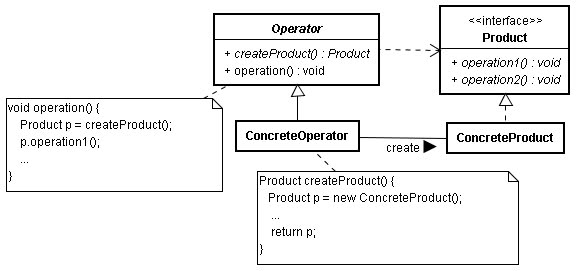Factory Method模式在一個抽象類別中留下某個建立元件的抽象方法沒有實作,其它與元件操作相關聯的方法都先依賴於元件所定義的介面,而不是依賴於元件的實 現, 當您的成品中有一個或多個元件無法確定時,您先確定與這些元件的操作介面,然後用元件的抽象操作介面先完成其它的工作,元件的實作(實現)則推遲至實現元 件介面的子類完成,一旦元件加入,即可完成您的成品。
簡單地說,如果您希望如何建立父類別中用到的物件這件事,是由子類別來決定,可以使用 Factory Method。
舉一個例子,假設您要完成一個文件編輯器,您希望這個編輯器可以適用於所有類型的檔案編輯,例如RTF、DOC、TXT等等,儘管這些文件有著不同的格 式,您先確定的是這些文件必然具備的一些操作介面,例如儲存、開啟、關閉等,您用一個Document類型來進行操作,這麼一來這個框架就無需考慮實 際的儲存、開啟等細節是如何進行的。
import java.util.*;
abstract class Document {
private String title;
String getTitle() {
return title;
}
void setTitle(String title) {
this.title = title;
}
abstract void open();
abstract void save();
abstract void close();
}
abstract class Editor {
private List<Document> docs = new ArrayList<Document>();
void open(String file) {
Document doc = createDocument();
doc.setTitle(file);
doc.open();
docs.add(doc);
}
void save(Document doc) {
doc.save();
}
void close(Document doc) {
doc.close();
docs.remove(doc);
}
void close() {
for(Document doc : docs) {
close(doc);
}
}
// ... 其它的方法定義
abstract Document createDocument(); // Factory method
}雖然這邊先以Java實作,但Document為abstract class或interface定義並不重要,重要的是Editor中,流程中所操作的都是Document的公開方法,實際上如何建立具體的 Document,則由子類別來完成,例如:
class TextEditor extends Editor {
Document createDocument() {
return new Document() {
void open() {
System.out.println("開啟文字檔案 " + this.getTitle());
}
void save() {
System.out.println("儲存文字檔案 " + this.getTitle());
}
void close() {
System.out.println("關閉文字檔案 " + this.getTitle());
}
};
}
}
public class Main {
public static void main(String[] args) {
Editor editor = new TextEditor();
editor.open("Main.java");
editor.open("Editor.java");
editor.close();
}
}
以UML圖來表示Factory method類別結構如下所示:

圖中Product指的是,物件必須具有Product所定義之公開協定,而 非專指Java中的interface定義。對於靜態語言來說,例如Java,必須使用型態來宣告變數,因此根據需求,可 以使用interfact或abstract class來定義Product所定義之公開協定。對於動態語言來說,例如 Python,真正的型態資訊是在物件之上(而非變數),因此要求的是物件必須具有Product之公開方法(無論是「哪 一種」物件),例如以下是Python的實現範例:
class Editor:
def __init__(self):
self.docs = []
def open(self, file):
doc = self.createDocument()
doc.title = file
doc.open()
self.docs.append(doc)
def save(self, doc):
doc.save()
def close(self, doc=None):
if doc:
doc.close()
self.docs.remove(doc)
else:
for doc in self.docs:
self.close(doc)
class TextDoc:
def open(self):
print("開啟文字檔案 " + self.title)
def save(self):
print("儲存文字檔案 " + self.title)
def close(self):
print("關閉文字檔案 " + self.title)
class TextEditor(Editor):
def createDocument(self):
doc = TextDoc()
# ...
return doc
editor = TextEditor()
editor.open("app.py")
editor.open("editor.py")
editor.close()
